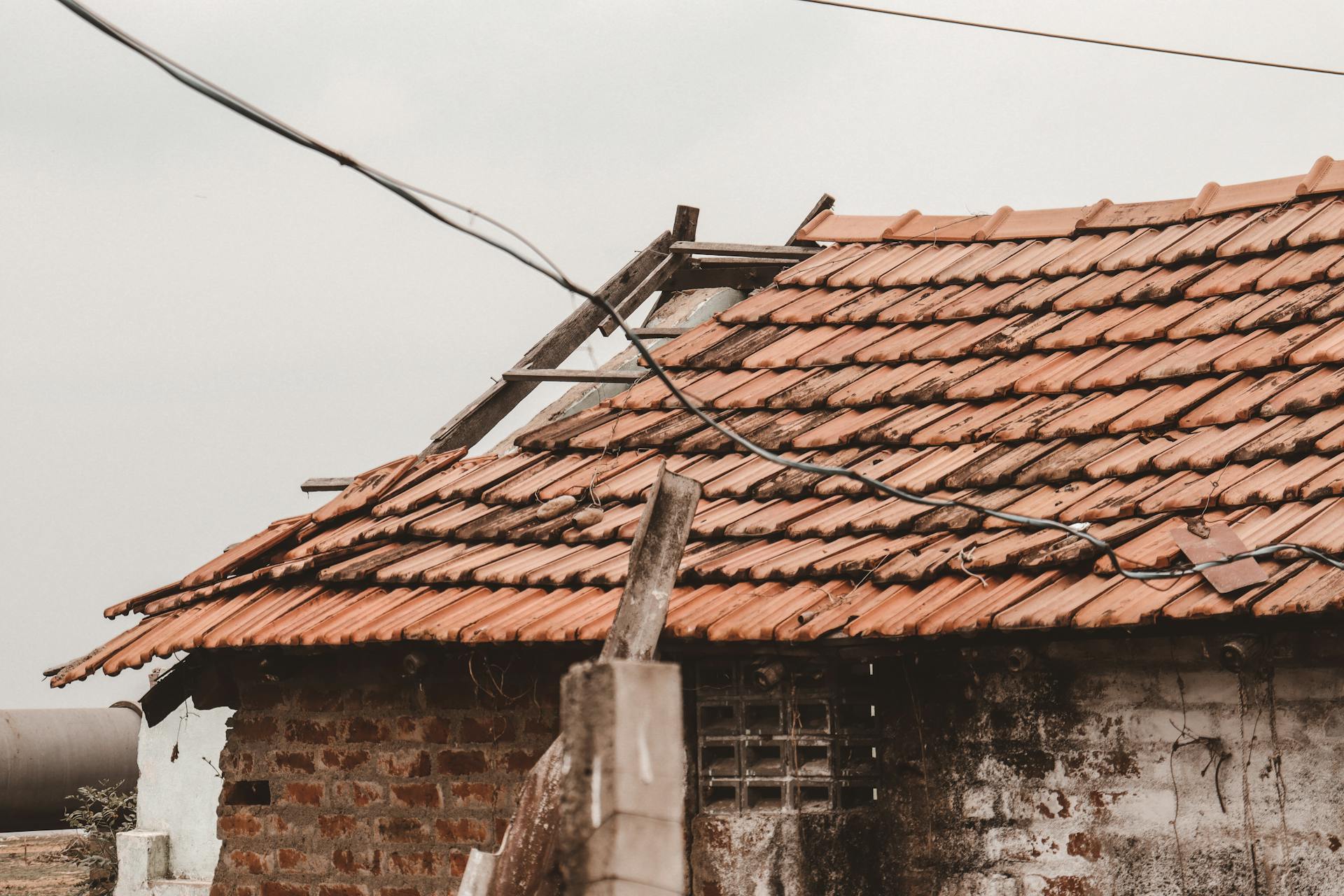
Insurance companies typically consider a 20-year-old roof to be near the end of its lifespan, with many roofs lasting between 20 to 30 years.
Most homeowners insurance policies cover damage to the roof, but the extent of coverage may vary depending on the policy and the cause of the damage.
A roof that's 20 years old may not be eligible for full replacement under a standard homeowners policy, but some policies may offer limited coverage for repairs or partial replacements.
Homeowners should review their policy documents to understand what's covered and what's not, as well as any potential deductibles or out-of-pocket expenses.
Check this out: House Insurance Public Liability
Insurance Coverage
Insurance coverage for a 20-year-old roof can be a bit tricky, but most insurance companies will cover damage caused by unforeseen or unpreventable events like storms, hail, or fallen trees. Some insurance companies won't provide coverage on a 20-year-old roof, period.
The type of roofing material you have can also affect insurance coverage. Asphalt shingle roofs, which are the most common type, have a 15 to 20 year lifespan and are more susceptible to wind damage. On the other hand, metal roofs can last 50 years or more and are more resistant to damage.
Check this out: Will Insurance Cover a 15 Year-old Roof
If your roof is damaged due to a covered peril, such as a storm, your insurance company may cover the repair or replacement costs. Damage from storms is typically considered a covered peril. Here are some common types of roof damage that are covered by insurance:
- Missing shingles
- Hail damage
- Wind damage
- Fallen trees or branches
- Ice damming
It's worth noting that insurance companies may require an inspection before approving a claim, and some may only cover partial damage. The specific requirements will vary depending on the insurance company and the type of roofing material you have.
Condition
The condition of your roof is crucial to insurance companies because it directly affects the overall integrity of your home. They want to ensure your home is adequately protected against potential hazards like water leaks and structural damage.
A damaged or worn-out roof increases the likelihood of these risks, which can result in costly claims for the insurance company. Insurance companies assess risk based on various factors, and roof condition is just one of them.
Related reading: How Long Will Insurance Cover a Metal Roof
Regular roof maintenance and prompt repairs are essential to ensure your coverage stays intact. Taking proactive steps to address any roof issues can save you from potential headaches and financial burdens in the future.
The condition of your roof matters, and if it's well-maintained and regularly inspected, you're more likely to have coverage.
You might enjoy: What Does Garagekeepers Insurance Cover
Factors Influencing Coverage
The lifespan of your roof depends on the material it's made of, with asphalt shingle roofs lasting 15 to 20 years and tile roofs lasting 50 years or more.
Damage resistance also plays a significant role, with some roofing materials more immune to pests, fire, and harsh weather than others. For example, synthetic asphalt shingles are more resistant to impact damage than typical asphalt shingles.
The type of insurance company you have also affects coverage, with some companies requiring roof inspections before updating your policy and others only covering some of the damage.
Here are some key factors to consider:
- Roof material: Different materials have varying lifespans and damage resistance.
- Damage resistance: Some materials are more resistant to damage than others.
- Insurance company requirements: Different companies have different requirements for roof coverage.
These factors can impact the availability and cost of insurance coverage for your 20-year-old roof.
Exclusions
Roof exclusions can be a major factor in determining whether or not your insurance company will cover damage to your roof. Most standard homeowner's insurance policies will cover damage caused by sudden and unexpected events, regardless of the age of the roof.
However, if your roof is in poor condition, insurance companies may exclude coverage for any damage related to the roof. This means you'll be left financially responsible for repairs or replacements. Some insurance companies won't provide coverage on a 20-year-old roof, period, especially if it's an older 3-tab asphalt shingle roof susceptible to wind damage.
Insurance companies are tightening their coverage options, limiting payouts, and even denying obvious claims due to the high cost of roof replacements and increased insurance claims. They don't want to assume the risk of an older roof that needs a replacement in the near future.
Here are some common reasons why insurance companies may exclude coverage for roof damage:
- Poor roof condition
- Age-related wear and tear
- Superficial damage (damage that's not causing problems)
- Neglect or maintenance issues
- Pest infestations (like squirrels causing extensive damage)
Understanding your policy and the terms and conditions related to roof coverage is crucial. Regular inspections by a qualified roofing professional can help identify and address issues before they become major problems.
5 Factors That Influence Coverage
Your insurance company's decision to cover your roof's damage is influenced by several factors. Here are the key ones to keep in mind:
Insurance companies may not cover a 20-year-old roof, period, especially if it's an older 3-tab asphalt shingle roof susceptible to wind damage. Some insurance companies require an inspection to determine the extent of coverage.
The type of roofing material used on your home can affect insurance coverage. Asphalt shingles have a 15 to 20 year lifespan, whereas tile roofs can last 50 years or more. This is one factor insurance companies consider when setting coverage.
The damage resistance of your roof's material is also a consideration. Some roofing materials, like synthetic asphalt shingles, are more resistant to impact damage than others.
If your roof is damaged by a sudden and unexpected event, such as a storm, your insurance company is likely to cover the repair or replacement costs. Storm damage is typically considered a covered peril.
The age of your roof can impact insurance coverage, but it's not the only factor. Insurance companies expect homeowners to maintain their roofs and perform necessary repairs to prevent wear and tear.
Here's an interesting read: What Are the Three Main Types of Property Insurance Coverage
Common Issues Leading to Non-Renewal or Cancellation
A 20-year-old roof is considered old, and insurance companies may view it as a potential risk. If your roof is approaching or surpassing its expected lifespan, insurance providers may hesitate to renew coverage.
Old roofs are not the only concern, however. Missing or damaged shingles, leaks, or structural damage can also raise red flags. This can lead to significant issues that could be costly to cover.
Regular maintenance is key to preventing these issues. Neglecting tasks like cleaning gutters and addressing small repairs may be viewed as negligence by insurance companies. This neglect can result in larger problems over time, prompting them to reconsider coverage.
Some roofing materials are considered high-risk by insurance companies. Homes with roofs constructed from materials like wood shakes or asbestos tiles may face insurance non-renewal or cancellation.
Here are the common issues leading to non-renewal or cancellation:
- Old or worn-out roof: approaching or surpassing its expected lifespan
- Missing or damaged shingles, leaks, or structural damage
- Improper roof maintenance: neglecting regular maintenance tasks
- Use of outdated or unsafe roofing materials: wood shakes or asbestos tiles
Replacement and Repair
If your 20-year-old roof is damaged by a covered peril, insurance will provide a payout for a new roof. However, whether they'll pay for a full roof replacement depends on the type of insurance policy.
With an Actual Cash Value (ACV) policy, you'll only get the depreciated value of your roof, which will never be enough to fully cover the cost of a roof replacement. Unfortunately, this means you'll be left with a significant gap in coverage.
A Replacement Cost Value (RCV) policy is supposed to give you enough to cover a full roof replacement, but insurance rarely gives you enough for a full roof replacement initially, even with an RCV policy. You'll need to put in the time to supplement your claim to get most or all of it covered.
If your roof is over 20 years old, your insurance may only cover the original cost, not the current replacement cost. This means you'll need to maintain photos, inspection reports, and records of repairs to ensure that your insurance claim is accepted.
Homeowners insurance may not fully cover the cost of replacing an older roof or damage resulting from normal wear and tear, but it can help with the cost of a new roof if specific events cause the damage.
Curious to learn more? Check out: Household Insurance Cover
Research and Planning
Researching insurance companies that specialize in covering older or damaged roofs can be a good starting point.
These companies understand the unique risks associated with roofs in poor condition and may be more willing to work with you.
To get homeowners insurance with a bad roof, you can take steps to secure coverage, such as researching and planning ahead.
If this caught your attention, see: Insurance Companies
Do Some Research
Researching insurance companies that specialize in providing coverage for homeowners with older or damaged roofs can be a game-changer.
These companies understand the unique risks associated with roofs in poor condition and may be more willing to work with you.
Researching online or asking for referrals from friends, family, or a real estate agent can help you find these specialized insurance companies.
You can also check with your state's insurance department to see if they have a list of licensed insurance companies that cater to homeowners with older or damaged roofs.
Some insurance companies may even offer discounts for homeowners who have taken steps to repair or replace their roofs.
Consider reading: Does Insurance Cover Landslides
Attracting Homeowners

If you're looking to attract homeowners, you'll want to consider the challenges they may face, such as needing insurance with a bad roof, like in the case of needing homeowners insurance with a bad roof.
Securing coverage can be a daunting task, but being aware of the steps to take can make a big difference.
In situations like needing homeowners insurance with a bad roof, there are steps that can be taken to secure coverage.
When to Contact Contractors
If your roof has been damaged, it's a good idea to contact a roofing contractor to determine the severity of the damage and whether it will be covered by your homeowner's insurance policy.
Typical homeowner's insurance policies will cover the cost of roof replacement if the damage was caused by an act of nature, regardless of the roof's age.
You should also contact a roofing contractor if you're unsure if the damage to your roof is your responsibility as a homeowner, as roofs that have surpassed their expected lifespan are generally not eligible for roof replacement.
If you're not sure what to do, speaking with a roofing contractor can provide you with the insight you need to make an informed decision about your roof's maintenance and repair.
See what others are reading: Does Homeowners Insurance Cover Injury to Owner
Frequently Asked Questions
How old can a roof be to get homeowners insurance?
For homeowners insurance, a roof typically needs to be 20 years old or less to be eligible for full replacement coverage. Older roofs may only be covered for their actual cash value or have limited coverage options.
Sources
- https://www.beyondexteriors.com/blog/roof-replacement-insurance-coverage/
- https://www.improveitmd.com/blog/homeowners-insurance-cancelled-because-of-roof
- https://www.billraganroofing.com/blog/will-insurance-cover-twenty-year-old-roof
- https://firstamericanroofing.com/will-insurance-cover-20-year-old-roof/
- https://southshorecontractorstampa.com/blogs/will-insurance-cover-a-20-year-old-roof/
Featured Images: pexels.com


